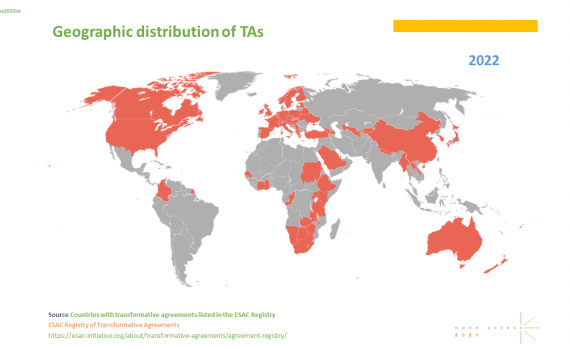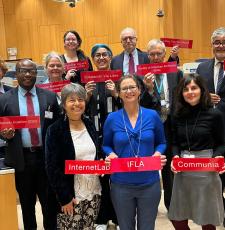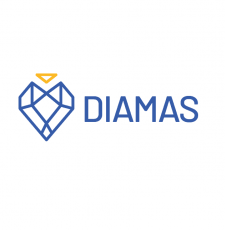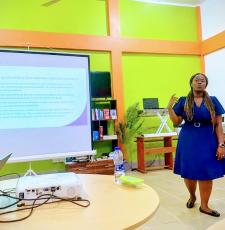
At the EIFL General Assembly 2022, licensing coordinators from EIFL partner countries shared their experiences of negotiating and managing transformative agreements. There have been positives, but also some challenges, writes EIFL Licensing Programme Manager Lorraine Estelle.
Transformative agreements (TAs) are agreements with publishers that transform the subscription business model for journals towards a fully open access publishing model. Their aim is to open up scholarship by increasing the amount of research published in open access, and to this end, repurpose library funds previously spent on subscription fees to cover the costs of open access publishing services. In their simplest iteration - called read and publish agreements - they combine subscription fees for accessing journal content with free or discounted article processing charges (APCs) to enable scholars to publish in open access at affordable prices or ideally, no cost to themselves.
EIFL has negotiated six TAs and some of the EIFL consortia have negotiated their own TAs. At the 2022 EIFL General Assembly, we asked EIFL licensing coordinators from Estonia, Lithuania, Serbia and Slovenia to share their experiences of negotiating and managing transformative agreements.
‘Incredible expansion’ of transformative agreements
Opening the discussion, Colleen Campbell, a member of the EFL Management Board, who also leads external engagement in the Open Access transition at the Max Planck Digital Library, described an “incredible expansion” in TAs, especially since 2018.
Colleen pointed to two events driving the expansion: the 14th Berlin Open Access Conference, where delegates committed to speed up publishing in open access through encouraging TAs, and a strong statement by Coalition S, a group of national and international research funders, that from 2021 all research funded by public or private grants must be published in open access.
“After that, we saw a huge growth in transformative agreements, from both bigger and smaller publishers. Even if libraries are not asking for transformative agreements, some publishers are actively proposing them,” said Colleen.
“The recent recommendation from the White House Office of Science and Technology Policy, in the USA, has recently issued a recommendation to public funding agencies to implement policies requiring authors to publish their research immediately in open access, either in open access journals or by depositing the authors accepted manuscript in a repository with zero embargo. It is expected that this recommendation will be a huge driver for publishers to flip from subscription to open access business models. This means that libraries and library consortia should start to prepare to negotiate with publishers for good conditions for open access service provisions in the coming few years,” Colleen concluded her presentation.
Positive outcomes - increase in open access publishing
The library consortia in Estonia, Lithuania, Serbia and Slovenia have signed a number of TAs, from having one agreement in Estonia to four in Lithuania.
The four speakers agreed - TAs are increasing the open access publishing.
For example, Tatjana Timotijevic cited the impact of a TA negotiated by the Serbian library consortium, KoBSON, with just one publisher. From 2017 to 2019, before the TA was signed, out of a total of 64 articles published with the publisher, just 2 were open access. After the TA, from 2021 to 2022, out of a total of 187 articles published, 77 were open access. “This is a significant increase, and it is also an increase in the overall number of articles published,” said Tatjana.
Some transformative agreements enable unlimited open access publishing, while others cap the number of open access articles that can be published each year at waived or discounted APCs. Capped open access agreements are often a cheaper option for consortia, but libraries need to provide more support to help authors understand the scheme and use the available vouchers or tokens for open access publishing.
Jevgenija Sevcova noted that a TA negotiated by the Lithuanian Research Library Consortium (LMBA) with a particular publisher, was capped at 17 open access vouchers, but in 2021 not all of these were used. The publisher allowed them to transfer these unused vouchers to the following year, understanding that authors need time to become familiar with new systems. This proved to be the case, and in 2022 authors in Lithuania are expected to use all 26 vouchers available to them for open access publishing with the publisher.
Challenge - the cost of transformative agreements
Although the libraries and library consortia would like to sign TAs, with some of the publishers it is difficult to negotiate affordable pricing. For example, Jevgenija (Lithuania) told us that one publisher quoted prices for a TA several times higher than the previous subscription agreement and as a result, the consortium had to cancel the negotiations.
However, other publishers are more reasonable about the pricing. Tatjana (Serbia), explained that they had a national ’read subscription with one publisher. They negotiated the inclusion of unlimited open access publishing in both hybrid journals and fully open access journals. This is proving good value for money: in the first nine months of 2022, eligible authors published 37 open articles. The list price of these APCs would be much more than the price paid for the TA.
Marika Meltsas told us that the Consortium of Estonian Libraries Network (ELNET) has only one TA. The cost allocation across members was a challenge because some member institutions publish a lot, and others hardly at all – it could have been difficult if they hadn’t central funding for the agreement. Estonia had not been able to afford to participate in any other TAs, she said, because the subscription budgets are already so tight they are having to consider cancellations.
Challenge - Open access publishing workflows
For authors, the process of submitting an article to a journal for open access publication can be very complex. Jevgenija (Lithuania) told us about one author who had to spend six hours working through the submission process. “I am not sure that all researchers will have such golden patience,” she said. “One of the important things we need to do is to ask publishers to provide us with very clear instructions so we and our colleagues from libraries can assist researchers if needed.”
Herman Erculj, of the Consortium of Slovene Electronic Collections (COSEC) reported struggles with a larger publisher whose systems were automated. “We were having problems with author recognition, journal eligibility, approval of article allocation on their open access dashboard, and invoicing. We received several false invoices that we have had to cancel and this takes a lot of time and effort. With a smaller publisher it is excellent, as everything is done manually by employees.”
Transformative agreements in the future
Transformative agreements are having an impact on open access publishing. But there is more work to be done, both by publishers and libraries to ensure that authors are aware of the opportunities and that submission systems are enablers rather than barriers.
And price is clearly an issue. As Colleen said, equitable scholarly journal publishing cannot be achieved if the payments to publish are as prohibitive as subscription fees for access. Pricing models need to change if more countries and institutions are to benefit from transformative agreements.
SHARE / PRINT








